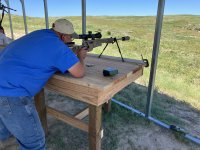Does a rifle with heavy recoil need to be held “tight” for accuracy? I generally find holding loosely gives me better accuracy with my .243 and .270. I often dont put my left hand on the forend at all.
Shooting my 28 nos and 300prc, I’ll usually hold the forend lightly with two fingers, or with my thumb under and two fingers laying on top of the barrel (which feels better, for some reason) See photos. Videos of me shooting show most of the recoil coming straight back, but the barrel does jump up an inch or so. Should I be holding tighter? I’m getting some fliers. Trying to see if the gun jumping up has anything to do with it.


Shooting my 28 nos and 300prc, I’ll usually hold the forend lightly with two fingers, or with my thumb under and two fingers laying on top of the barrel (which feels better, for some reason) See photos. Videos of me shooting show most of the recoil coming straight back, but the barrel does jump up an inch or so. Should I be holding tighter? I’m getting some fliers. Trying to see if the gun jumping up has anything to do with it.


